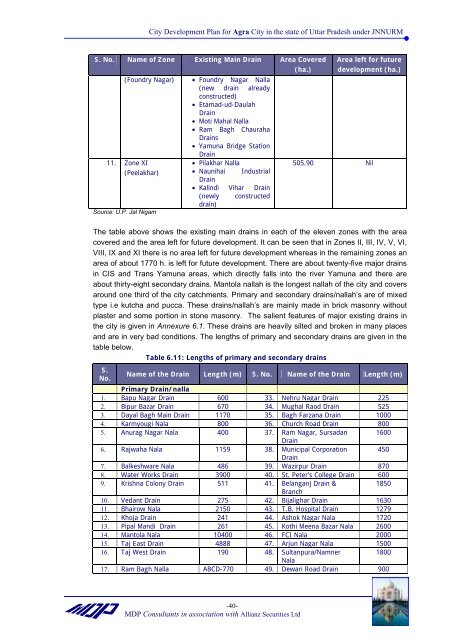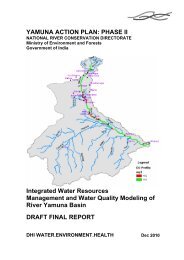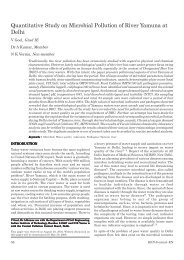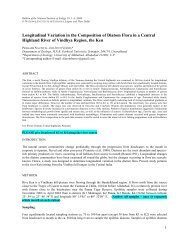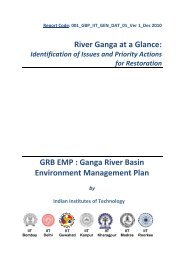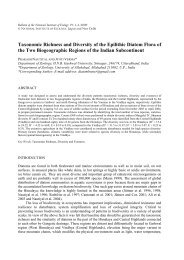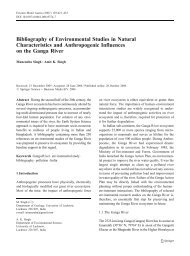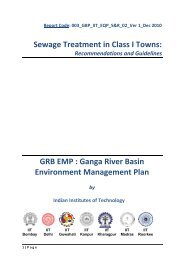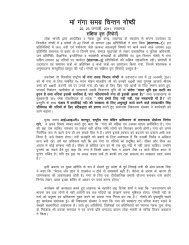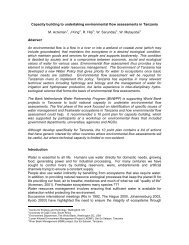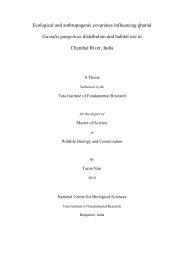JNNURM - GANGAPEDIA
JNNURM - GANGAPEDIA
JNNURM - GANGAPEDIA
Create successful ePaper yourself
Turn your PDF publications into a flip-book with our unique Google optimized e-Paper software.
City Development Plan for Agra City in the state of Uttar Pradesh under <strong>JNNURM</strong><br />
S. No. Name of Zone Existing Main Drain Area Covered<br />
(ha.)<br />
(Foundry Nagar) • Foundry Nagar Nalla<br />
(new drain already<br />
constructed)<br />
• Etamad-ud-Daulah<br />
Drain<br />
• Moti Mahal Nalla<br />
• Ram Bagh Chauraha<br />
Drains<br />
• Yamuna Bridge Station<br />
Drain<br />
11. Zone XI<br />
(Peelakhar)<br />
Source: U.P. Jal Nigam<br />
• Pilakhar Nalla<br />
• Naunihai Industrial<br />
Drain<br />
• Kalindi Vihar Drain<br />
(newly constructed<br />
drain)<br />
-40-<br />
MDP Consultants in association with Allianz Securities Ltd<br />
Area left for future<br />
development (ha.)<br />
505.90 Nil<br />
The table above shows the existing main drains in each of the eleven zones with the area<br />
covered and the area left for future development. It can be seen that in Zones II, III, IV, V, VI,<br />
VIII, IX and XI there is no area left for future development whereas in the remaining zones an<br />
area of about 1770 h. is left for future development. There are about twenty-five major drains<br />
in CIS and Trans Yamuna areas, which directly falls into the river Yamuna and there are<br />
about thirty-eight secondary drains. Mantola nallah is the longest nallah of the city and covers<br />
around one third of the city catchments. Primary and secondary drains/nallah’s are of mixed<br />
type i.e kutcha and pucca. These drains/nallah’s are mainly made in brick masonry without<br />
plaster and some portion in stone masonry. The salient features of major existing drains in<br />
the city is given in Annexure 6.1. These drains are heavily silted and broken in many places<br />
and are in very bad conditions. The lengths of primary and secondary drains are given in the<br />
table below.<br />
S.<br />
No.<br />
Table 6.11: Lengths of primary and secondary drains<br />
Name of the Drain Length (m) S. No. Name of the Drain Length (m)<br />
1.<br />
Primary Drain/nalla<br />
Bapu Nagar Drain 600 33. Nehru Nagar Drain 225<br />
2. Bipur Bazar Drain 670 34. Mughal Raod Drain 525<br />
3. Dayal Bagh Main Drain 1170 35. Bagh Farzana Drain 1000<br />
4. Karmyougi Nala 800 36. Church Road Drain 800<br />
5. Anurag Nagar Nala 400 37. Ram Nagar, Sursadan<br />
Drain<br />
1600<br />
6. Rajwaha Nala 1159 38. Municipal Corporation<br />
Drain<br />
450<br />
7. Balkeshware Nala 486 39. Wazirpur Drain 870<br />
8. Water Works Drain 3900 40. St. Peter’s College Drain 600<br />
9. Krishna Colony Drain 511 41. Belanganj Drain &<br />
Branch<br />
1850<br />
10. Vedant Drain 275 42. Bijalighar Drain 1630<br />
11. Bhairow Nala 2150 43. T.B. Hospital Drain 1279<br />
12. Khoja Drain 241 44. Ashok Nagar Nala 1720<br />
13. Pipal Mandi Drain 261 45. Kothi Meena Bazar Nala 2600<br />
14. Mantola Nala 10400 46. FCI Nala 2000<br />
15. Taj East Drain 4888 47. Arjun Nagar Nala 1500<br />
16. Taj West Drain 190 48. Sultanpura/Namner<br />
Nala<br />
1800<br />
17. Ram Bagh Nalla ABCD-770 49. Dewari Road Drain 900


